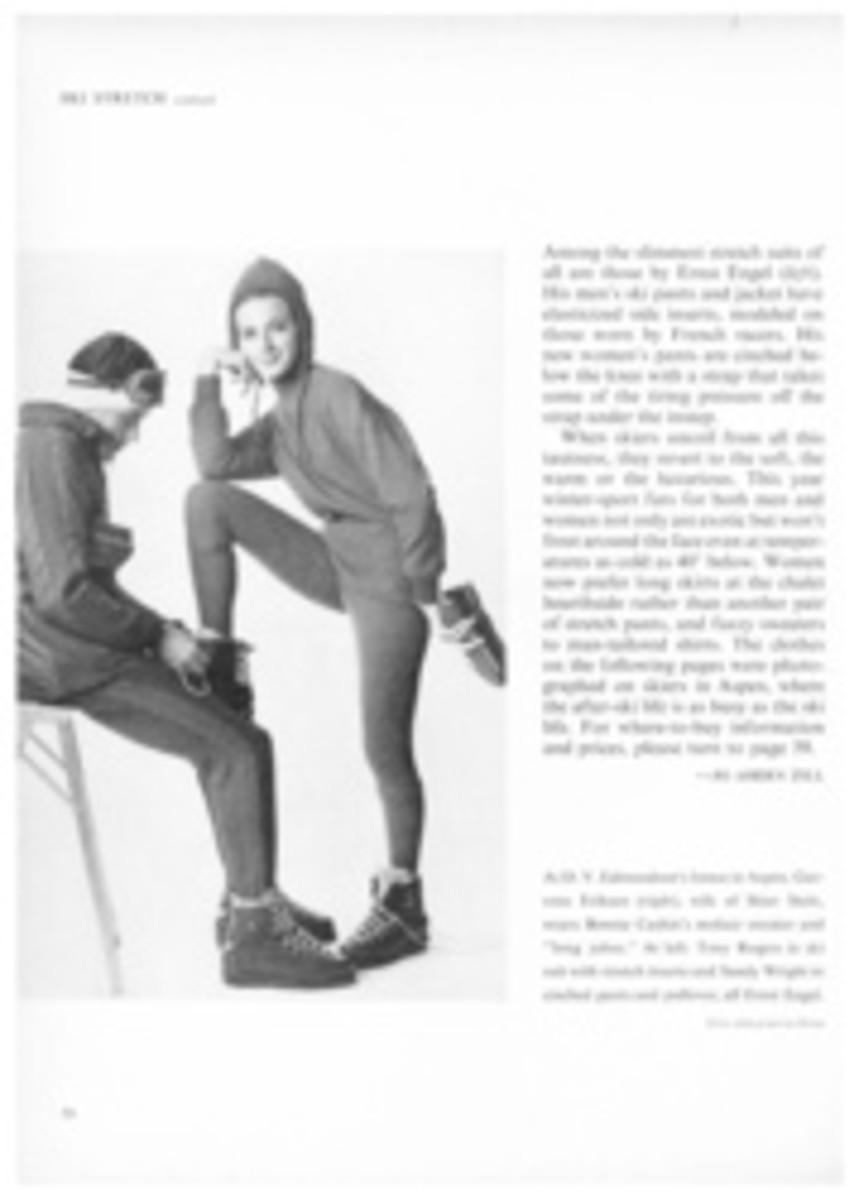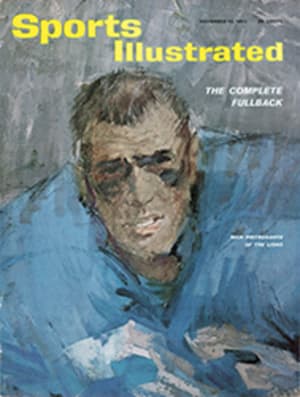
SKIING MOVES RAPIDLY UPHILL
Skiing today is securely established as a sport within the competence of any healthy person. For years it was something rich daredevils did on dangerous foreign mountains. You saw it in films or read about it in adventure books, but it was not anything you would dream of doing yourself. The change came after World War II, with larger leisure, more money and a new familiarity with the sport.
Its popularity is still growing. The country has two million skiers and last year more than $30 million was spent on equipment—skis, poles, boots and bindings. This season both figures are likely to be larger. Ski resorts, not all of them wantonly luxurious, are within reach of almost every section of the country, even those where snow is more often man-made than heaven-sent. As skiers become more skillful in the sport, they are more exacting in their needs. For instance, the casual skier realized he didn't know how to test or adjust his release bindings. He often set them so tightly that his foot didn't free in an awkward twist or bad spill. He therefore demanded an uncomplicated binding that didn't need constant or involved adjustment to function properly. Along with safety, he became aware of appearance and wanted a simple compact unit—the less hardware, the better. With boots it wasn't enough that you could snap them open for comfort and didn't have to bother with tedious lacing. The skier needed lateral support and a precise fit for his short-swing turns. This doesn't mean he is willing to pay the penalty of blisters for the benefit of stiff leather. He wants a boot that makes skier and skis a single unit without sacrificing his comfort. The recreational skier requires light, durable poles, and the trend is toward longer poles, tapered for balance and with smaller baskets. Nowadays most prefer aluminum, but lightweight steel, according to some experts in the industry, shows signs of being the pole of the future. As skiers began to travel more to areas abroad and throughout the U.S., the need for a ski that would be effective in all snow conditions and over varied terrains became apparent. Plastic skis are gaining wider acceptance as they meet these demands, but wood and metal still have their partisans. Ski accessories have also been influenced by the knowledgeable skier. In a field that includes everything from face masks and poodle parkas to hand warmers there is a growing trend toward the practical and year-round item.
BOOTS BUILT FOR PRECISE FIT
The new Lange boot ($79.50) is plastic and has an unusual loose lining. For each boot there is a plastic sack (above left), and when its contents are mixed together a chemical reaction takes place. Once activated, this sack is slipped into a pocket between the lining and outer shell and then the boot is put on and laced. The sack forms into a rubberlike material permanently molded to the shape of the ankle to give custom ft and improved control over ski edges.
The new Henke Speedfit Racer ($79.50) is designed for the expert rather than the casual skier. It is made of extremely stiff leather with felt lining to give maximum support in high-speed turns. Henke also has refined the snap on all adult Speedfit models. The new feature, Eccentric Fit Selector (above left), permits eight different adjustments for each snap. The boots are easily flipped open, and the skier can find the fit best suited for control of his skis.
QUEST FOR THE BEST
Ski designers are still experimenting in the hope of improving riding quality and finding a ski (of whatever material-wood, metal or plastic) that is perfect in all snow conditions, whether blue ice or deep powder. The world's best racers have won championships both here and abroad on all three types and, what's more, switched from one type to another in various events.
At the end of last season the most skis sold in this country were still wood. But manufacturers have maintained a silence about new features on the wood ski. The fact is that there are none of importance. Thus it remains a stiff ski that tracks well on hard-packed snow but is extremely tricky to handle in deep powder. For this reason, in recent years there has been a steady change-over to metal skis by the recreational skier, and the 1960 Olympics showed what they could do in racing. But the early metal skis tracked poorly and clattered like tin cans on ice. Certain metal skis, when flexed, still over-bend and take on the action of a tuning fork, going past the normal position and setting up a vibration that makes the ski difficult to control. This season, however, there are more metal makes on the market, including one imported from Japan.
The plastic (fiber glass and epoxy resin) skis are quiet on ice, have the flexibility needed for deep powder and have a fast rate of return to normal position without vibration. Fiber glass has been used successfully in boats, bows and guns, and epoxy resin in rocket tips. There is every reason to believe that these materials will be equally successful in skis Following are some examples of plastic skis now available on the market.
The Swift Fiberglass ski is being imported by Hedlund from West Germany for the first time. Its front and tail sections are of solid reinforced fiber glass (upper right) for resiliency, while the center section (lower right) has a laminated hardwood core encased in fiber glass. The ski costs $129.50 and the flex and turning characteristics are of exceptionally high quality, making a good riding ski in all types of snow for skiers of varying ability.
The Plymold Glasski sells for $105, with hidden edges, $130. A solid wood core runs the length of the ski with reinforced fiberglass sections on the top and bottom (above right). The polyethylene running surface is specially treated so that it can be bonded directly to the ski. Skiers who have tested them say they handle well in all snow conditions, are extremely durable, and do not fatigue. The ski is in direct contact with the snow at all times; because of the quality of its fiber glass this ski has fast recovery to its normal position after being flexed, and it remains inert after returning to the normal position.
The Kneissl White Star plastic ski is designed for racers and recreational skiers alike. All models have a polyethylene base, hidden edges and a year's guarantee against breakage and defects. Plastic to Kneissl means epoxy resin. Epoxy sheets, said to have 10 times as much resiliency as aluminum, are fused on a wood skeleton core with air chambers (above right) by means of liquid epoxy resin. The result is a ski that-so it is claimed-doesn't fatigue, has elasticity and flexibility and is practically unbreakable. Due to its elasticity the ski levels out any unevenness of the ground, and it rides with ease and speed even in deep snow. There is no swerving to the side in deep powder; the ski is easily maneuverable and it grips on ice. Being insensitive to temperature changes, it doesn't warp or lose its camber. In spite of the alarming terminology—suggestive of Dr. Faustus and the witches' scenes in Macbeth—the working of the ski is simplicity itself. The ski costs $195—which makes it the Rolls-Royce of the ski industry.
A DURABLE POLE
Scott-USA is bringing out a lightweight steel pole (S23.95) to compete with the company's own successful aluminum model. After three winters they found that aluminum can be scratched and cut by the sharp ski edges. Scott's solution, after a season of testing by FIS team members, is a steel not only as strong but as light as aluminum and many times more durable. The new lightweight pole does not have the usual inserted steel point but is one piece from its canted pistol grip to the tip (dotted line above). This naturally reduces weight at the critical location, the bottom end, and makes the point lighter, neater looking and immune to loosening and falling out.
A PRACTICAL TOE PIECE
Hjalmar Hvam, the pioneer of the safety binding, has refined his Saf-Ski toe release. The Hvam toe piece ($7.95) is designed specifically for skiers of all weights, guaranteed not to freeze—and most important of all—is automatic. This eliminates the danger of a skier improperly setting the release mechanism (the cause of many ski injuries) and makes it easy to get in and out of. The toe swivel must move slightly downward before it can rotate to release. When a skier spills, the upward pressure is removed and the boot comes out of the toe binding (arrow above). The catchy slogan, "Hvoom with Hvam and have no fear," appears to have some merit.
EIGHT ILLUSTRATIONS
DON MOSS

